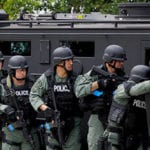 Mysteries
Mysteries  Mysteries
Mysteries  Miscellaneous
Miscellaneous 10 of History’s Most Bell-Ringing Finishing Moves
 History
History 10 Great Escapes That Ended Right Back in Captivity
 Weird Stuff
Weird Stuff 10 Fascinating Things You Might Not Know About Spiders
 Food
Food 10 Everyday Foods You Didn’t Know Were Invented by the U.S. Military
 History
History 10 Odd Things Colonial Americans Kept at Home
 Weird Stuff
Weird Stuff 10 Superstitious Beliefs That Once Consumed Entire Cultures
 History
History 10 Bizarre Friendly Fire Incidents in Military History
 Technology
Technology 10 Modern Technologies That Accidentally Imitate Ancient Magic
 Mysteries
Mysteries 10 Mysteries of the Human Genome
 Mysteries
Mysteries 10 Strange Unexplained Mysteries of 2025
 Miscellaneous
Miscellaneous 10 of History’s Most Bell-Ringing Finishing Moves
 History
History 10 Great Escapes That Ended Right Back in Captivity
Who's Behind Listverse?

Jamie Frater
Head Editor
Jamie founded Listverse due to an insatiable desire to share fascinating, obscure, and bizarre facts. He has been a guest speaker on numerous national radio and television stations and is a five time published author.
More About Us Weird Stuff
Weird Stuff 10 Fascinating Things You Might Not Know About Spiders
 Food
Food 10 Everyday Foods You Didn’t Know Were Invented by the U.S. Military
 History
History 10 Odd Things Colonial Americans Kept at Home
 Weird Stuff
Weird Stuff 10 Superstitious Beliefs That Once Consumed Entire Cultures
 History
History 10 Bizarre Friendly Fire Incidents in Military History
 Technology
Technology 10 Modern Technologies That Accidentally Imitate Ancient Magic
 Mysteries
Mysteries 10 Mysteries of the Human Genome
10 Movies That Test Screenings Changed
During the shooting of a movie or after filming is completed, almost all directors show the result to at least one test screening audience. Although most filmmakers don’t enjoy the experience of hearing their creations critiqued by viewers, movies often do benefit from the process. Audiences are perceptive, and they know what they like. For producers and investors, who lay out millions of dollars to finance full-length feature films, giving audiences what they want is critical, so it’s likely that test screening results will be weighed carefully. As a result, changes to movies are often made.
More rarely, the results of test screenings affirm the quality and entertainment value of a movie. Test screenings also give those who aren’t part of show business a glimpse into the concerns and intentions of the people who work in this profession. No matter the viewers’ findings, test screening audiences’ responses almost always have a direct effect on the movie’s final cut and the version of the film that appears on theater screens.
10 Sunset Boulevard
Early films consisted of several reels. Each held approximately 300 meters (1,000 ft) of 35-millimeter film and ran about 12 minutes. Toward the end of a reel, a small, black oval would briefly appear in the top-right of the screen to signal the projectionist it was almost time to switch to the second projector, upon which the next reel of film was mounted, ready to be shown.
Sunset Boulevard ‘s (1950) director, Billy Wilder, decided to cut the first reel from the movie after showing it during a test screening. Although we may never know what the test screening audiences objected to or what sequence of images was left on the cutting room floor, we can be certain the footage didn’t pass muster with the viewers who did see it.[1]
It seems Wilder’s decision was a wise one. Sunset Boulevard, an American noir film, is generally regarded as one of Hollywood’s best movies, particularly for Gloria Swanson’s depiction of a movie star past her prime.
9 Licence To Kill
Licence Revoked, the original title of the James Bond film that would become Licence to Kill (1989), starring Timothy Dalton in the title role, didn’t sit well with its American test screening audiences. License Revoked, they said, was too reminiscent of a visit to the Division of Motor Vehicles.[2]
Apparently, viewers also preferred the British spelling, “Licence,” to the American variant, “License,” because the former, not the latter, made the movie’s final cut. Bond is, after all, a British secret agent.
8 Little Shop Of Horrors
Director Frank Oz’s original ending for Little Shop of Horrors (1986) wasn’t exactly what test screening viewers had in mind. Oz’s version was too dark for their tastes: The musical horror comedy’s botanical monster, Audrey II, devours nerdy lovebirds Seymour Krelborn (Rick Moranis) and Audrey (Ellen Greene) before going on a rampage.
Despite some impressive and humorous special effects, which include the monstrous plants swallowing a train and cackling atop the Statue of Liberty, the sequence of Audrey II’s attack on New York City was so long that it was described as “tedious,” but test screening audiences didn’t complain about its seemingly endless repetitions of collapsing buildings and terrified people fleeing for their lives. They criticized the fates of Seymour and Audrey. They wanted a happy ending for the geeky couple.
Oz gave the audiences what they wanted, substituting an ending in which Seymour and Audrey defeat Audrey II and move happily to the suburbs.[3]
7 The Mighty Quinn
Test screening audiences don’t always concern themselves with only a movie’s plot, actors’ performances, special effects, and the picture’s theme. Their own feelings and prejudices sometimes determine the direction a movie will take or how a scene will play out in the film’s final cut. Such was the case with The Mighty Quinn (1989), in which Denzel Washington plays police chief Xavier Quinn, opposite Mimi Rogers’s Hadley Elgin.
In the film, Quinn and Elgin exchange a kiss, but the kiss never made it to the big screen. It was cut, Washington said, because it didn’t go over well with test screening audiences. “Black women hated the scene. White men hated the scene.”[4]
6 Jaws
The results of test screenings sometimes improve a movie, as Steven Spielberg and his crew discovered when they showed an early cut of Jaws (1975) to a Midwestern audience. Viewers in Dallas, Texas, were so shocked by the “pop-up scare” that occurs when the great white shark breaches the surface of the water as police chief Martin Brody (Roy Scheider) chums off the bow of the boat that their “vocal reactions” drowned out his ironic comment to shark-hunter Quint (Robert Shaw), “You’re gonna need a bigger boat.”
After reviewing their taping of the moment, the filmmakers extended the sequence, adding another 10.6 meters (35 ft) of film to give the audience enough time to recover to enjoy the “much-needed moment of comic relief” provided by Brody’s line.[5]
5 Clear And Present Danger
In the scene in Clear and Present Danger (1994) in which drug cartel leader Ernesto Escobedo’s henchman Felix Cortez is killed, test screening audiences applauded, or tried to do so. The brevity of the scene prevented them. According to producer Mace Neufeld, the scene was over before they could clap. As a result of the test screening, footage was added.
In other cases, to produce the movie on time, as Paramount Pictures demanded, director Philip Noyce cut footage, only to lengthen the entire film to 142 minutes after the studio encouraged him to extend its running time. The reason for Paramount’s turnaround seems to have been viewings by additional test screening audiences. The cuts “didn’t seem to make it better, just shorter.” Ironically, the cuts also made the film seem longer to audiences, Noyce said, “than when it was long.”[6]
4 The Bourne Supremacy
Occasionally, test screenings don’t suggest new edits of film footage as much as they confirm a director’s decisions. Director Paul Greengrass met with Matt Damon, star of The Bourne Supremacy (2004), and conceived what he thought would be a better ending.
After Greengrass pitched his idea to the movie’s producers, they “reluctantly agreed” to allow him to proceed as planned, despite the additional $200,000 cost and the need to postpone Damon’s work on Ocean’s Twelve. Once the new ending was complete, the movie was shown to test screening audiences. It scored ten points higher with Greengrass’s new ending in place.[7]
3 Troy
Troy (2004) was a lavish production, epic in scope and starring Brad Pitt as Achilles. The film company took over part of Malta to shoot the film at a cost of $175 million. With magnificent costumes and sets and a spectacular cast, including Peter O’Toole and Orlando Bloom, the movie would attempt to recreate Greek warriors’ attack on Troy during the Trojan War. Despite high production values, the motion picture did not fare well before test screening audiences, who objected to movie’s music. It was “too brassy and too bold,” viewers said, and not cutting-edge enough for modern audiences’ tastes.
The studio’s first response was to freak out. Composer Gabriel Yared was fired, and his musical score was removed from the film. James Horner, who replaced Yared, said his predecessor’s music was indescribably “atrocious.” Horner compared Yared’s score to music such as might have been recorded for “a 1950s Hercules movie,” so “corny . . . it was unbelievable.”
Horner also blamed director Wolfgang Petersen. “Gabriel dutifully did whatever was asked of him by Wolfgang, and Wolfgang’s musical tendencies are to overscore everything, like a Wagner opera. He’s not into subtlety,” Horner said. As a result of the original score, audiences laughed during scenes that were meant to be serious.
Music critics, kinder to Yared than Horner had been, praised and admonished both composers for different reasons. One reviewer even blamed the test screening audiences, suggesting they didn’t “appreciate [Yared’s] unusually large presentation of orchestral power.”[8]
2 American Gangster
The American gangster in Ridley Scott’s eponymous 2007 film is a fictional version of Frank Lucas, the African American drug lord who operated out of his Harlem, New York, territory. He smuggled loads of high-grade heroin into Harlem inside the coffins of dead Vietnam veterans. Denzel Washington plays Lucas. Russell Crowe plays Lucas’s nemesis, Detective Richie Roberts.
Scott ducked into the first test screening of the movie. As soon as the first viewer moved, the director planned to sneak out, but at the end of the showing, Scott was still in his seat. Not a single viewer had left. Their reactions showed Scott he had a winner on his hands. “No one moved,” he recalled, “so neither did I. That was what was most rewarding; knowing that you’ve fully engaged people with the truth.”[9]
1 Clerks II
Kevin Smith, who wrote and directed the comedy Clerks II (2006), wasn’t looking forward to the only test screening of his film that the producers had required. To be selected, potential test screening viewers had to have seen three of the films on a “Qualifying Films” list. The problem was that none of the movies in which Smith had previously been involved were listed. The available viewers also didn’t necessarily fit the profiles of people who’d be likely to enjoy Smith’s brand of humor.
Even though the results of the test screening wouldn’t be used, in this instance, to edit the film—its purpose was to determine how to market the movie—Smith felt nervous. “Of all the aspects of filmmaking that go into the gestalt of cinematic storytelling, [screen testing] is definitely the least appetizing,” he said. “I don’t know any filmmaker who enjoys it.”
He was pleasantly surprised by the Midwest audience’s response. Viewers applauded frequently during the showing of the movie, and 84 percent of them rated the movie as either “excellent” or “very good.” The test screening the producers had required “was definitely worth all the worry leading up to it,” Smith said.[10]
Leigh Paul enjoys reading and writing, but she’s not crazy about arithmetic.
Read more behind-the-scenes facts about your favorite movies on 10 Brilliant Directors Who Were Notoriously Cruel and Top 10 Horrible Facts About Iconic Holiday Movies.








